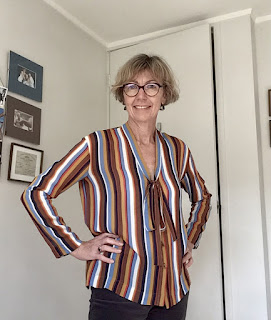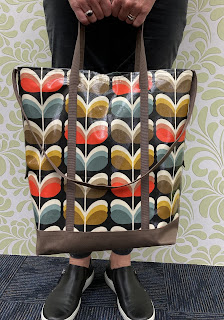Once again it delights me to sew up a New Zealand designed Indie Sewing Pattern. This is the Ivy Pinafore by Jennifer Lauren Handmade.
Some of the things I wish to make are better or different versions of current wardrobe staples, which is the case here. I have two pinafores which I find very easy work wear. Sometimes a dress is a bit of a commitment. I will put it out there and say when you are tall, I am 5'9", a dress can be a lot of one fabric. A layer underneath breaks it up. At least that is my thinking. My current pinafores are both winter weight, and were both recycle finds. This one is from New York making it all the more special.
I did some research and thought this pattern would be a good start. I used fabric from The Fabric Store, a fine suiting with some stretch, and a striped lining.
Fitting. I am coming to realise how little attention I have paid to fitting in pretty much all my sewing. Sure I have consistently added length, but little else. For years I sewed mainly Vogue patterns - remember those half price pattern sales - and the results worked well enough for me not to have to drill down into any detail. But entering the world of online pattern reviews, and the wealth of resources online opens up space to make better fitting clothes - well that is the current goal.
Confession - I have never made a toile or muslin, and realistically I do not think I ever will. I took a series of sewing classes in the early 1990s where our teacher, Judith Whyman, taught us to measure our bodies, and check that against the pattern pieces - that made sense to me.
Reading some online reviews about the Ivy there were comments about it being full in the bust. I was concerned, I am a B cup, so I asked Jennifer Lauren herself. She helpfully considered my measurements and advised I would probably be OK.
Then I graded from a size 12 to a size 14 at the bottom and added 20 centimetres to the length. If that sounds like a lot of extra length, it was, too much. What was I thinking? The pattern gave be a finished measurement from the underarm. In the end I cut off about 10cm before hemming - lesson there.
I am not sure why I decided I needed a size 14 from the waist down as my hip measurement put me in a size 12.
Process. It is helpful now to write onto the instructions the point at which I will stop and baste and try on. In this case that was after attaching the front and back neckbands. The top fit was perfect, whilst the bottom was sack like! You know I find it easy to feel this is a stuff up; having to unpick and resew, well it feels like I have made a mistake. I am trying to re-frame this into a natural part of the process.
The pattern goes together quite simply. The instructions are clear. I did wonder about he need for a centre front seam and possibly I would omit that next time. This garment does have the stressful final step of button holes in a very prominent position. Not to mention the choice of buttons! I found something in my collections, and talked myself through the decision with the proviso that I can always change them later!
Claire



























